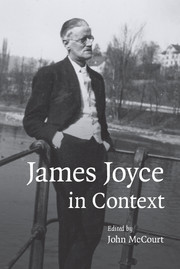Book contents
- Frontmatter
- Contents
- Notes on contributors
- Preface
- List of abbreviations
- PART I LIFE AND WORKS
- PART II THEORY AND CRITICAL RECEPTION
- PART III HISTORICAL AND CULTURAL CONTEXTS
- 14 Being in Joyce's world
- 15 Dublin
- 16 Nineteenth-century lyric nationalism
- 17 The Irish Revival
- 18 The English literary tradition
- 19 Paris
- 20 Trieste
- 21 Greek and Roman themes
- 22 Medicine
- 23 Modernisms
- 24 Music
- 25 Irish and European politics: nationalism, socialism, empire
- 26 Newspapers and popular culture
- 27 Language and languages
- 28 Philosophy
- 29 Religion
- 30 Science
- 31 Cinema
- 32 Sex
- Further reading
- Index
26 - Newspapers and popular culture
Published online by Cambridge University Press: 14 July 2009
- Frontmatter
- Contents
- Notes on contributors
- Preface
- List of abbreviations
- PART I LIFE AND WORKS
- PART II THEORY AND CRITICAL RECEPTION
- PART III HISTORICAL AND CULTURAL CONTEXTS
- 14 Being in Joyce's world
- 15 Dublin
- 16 Nineteenth-century lyric nationalism
- 17 The Irish Revival
- 18 The English literary tradition
- 19 Paris
- 20 Trieste
- 21 Greek and Roman themes
- 22 Medicine
- 23 Modernisms
- 24 Music
- 25 Irish and European politics: nationalism, socialism, empire
- 26 Newspapers and popular culture
- 27 Language and languages
- 28 Philosophy
- 29 Religion
- 30 Science
- 31 Cinema
- 32 Sex
- Further reading
- Index
Summary
Joyce's work, especially Ulysses, is packed with references to popular culture of all sorts and from a variety of social levels – newspapers and magazines (including ‘penny dreadfuls’), popular novels (from romance to pornography) and plays, advertisements, entertainments of all sorts, from the music hall and pantomime to local concerts such as we see in ‘A Mother’. Events such as the Gordon Bennett car race in ‘After the Race’ or the bazaar in ‘Araby’ certainly qualify, as does much of the ‘street furniture’ that Joyce evokes, such as the Turkish Baths where Bloom refreshes himself. Also under the rubric of popular culture are well-known figures of the day as difficult to classify as Eugen Sandow the bodybuilder (who upon examination turns out to be an author, magazine publisher, musician, advisor to the King and a US President, and founder of a series of exercise salons for men and women – as well as being Bloom's chosen physical trainer).
If Theosophy may be seen as a variety of religion and thus belongs to a high cultural category, surely the late Victorian bourgeois vogue for spiritualism to which Joyce alludes in ‘Scylla and Charybdis’ is also a form of popular culture, as are celebrity priests such as the egregious ‘Father Purdon’ of ‘Grace’ who elicit a reaction from their following not unlike that evoked by a matinee idol of the time such as Martin Harvey.
- Type
- Chapter
- Information
- James Joyce in Context , pp. 299 - 308Publisher: Cambridge University PressPrint publication year: 2009
- 1
- Cited by



